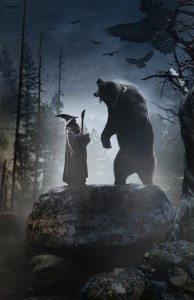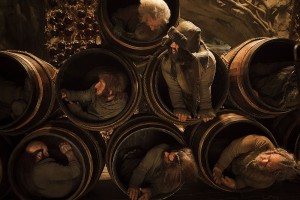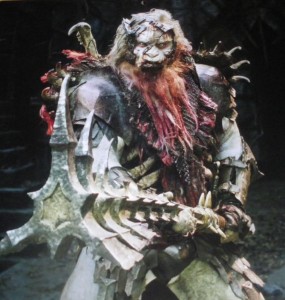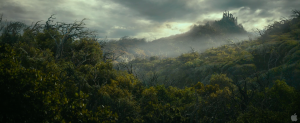Film II: The Desolation of Smaug

Beginning the second film with the Company’s rest at Beorn’s house will allow for the set-up the bifurcation of the story shortly after, which occurs at the eaves of Mirkwood, where Gandalf breaks from the troupe and heads south to deal with the Necromancer. Let’s look at what the two threads of the story might look like. The rest at Beorn’s will also mirror the opening of film one, where the Company make their plans at Bag End. In the book, Beorn warns them of what lies ahead in Mirkwood.
With regard to the Company, they will of course first face the dark and treacherous journey through Mirkwood: the glistening eyes in the dark; the loss of arrows; the enchanted stream; the search for the lights in the forest; the incident with the spiders. All this will likely be rushed through reasonably quickly, as while horrifying, it has little relation to the rest of the story per se, especially given this will now be part of a film entitled The Desolation of Smaug. The whole episode in Mirkwood is, largely, merely a set up to allow for their capture by the elves and their escape to Laketown in barrels.
It would seem that Legolas will capture the Dwarves, and that the new female character of Tauriel will be the head of the elven guard, from whom the Dwarves escape. This sequence is likely to be elaborately choreographed, with Bilbo springing the various dwarves from their cells and evading the guards.

This ‘thriller’ escape sequence will be necessary as the Company’s subsequent arrival in Laketown will involve a lot of dialogue and a sense that they spend some time there recuperating. In this, the break at Laketown will to some extent mirror the break during the first film at Rivendell. Whereas Rivendell provides the set up for the broader story as it relates to LotR (particularly the meeting of the White Council), the break at Lake-town establishes the Long Lake and Lonely Mountain as a dramatic context for the second half of the Hobbit trilogy.
The arrival in Lake-town will also need to linger as it is introducing an entirely new culture, much like Rohan in The Two Towers (TTT). Like Rohan, Lake-town is controlled by a corrupted ruler (Theoden was under a spell; the Master of Lake-town is corrupt). Like Rohan, Lake-town introduces a young protagonist, who begins the film as an outcast, but who is rehabilitated and becomes a hero by the end of the film (Eomer in TTT; Bard here).
The film will then of course then have to follow Bilbo and the Dwarves on their mission to the mountain via the ruins of Dale – again perhaps having to avoid Fimbul’s warg riders who continue to harry them. Following this is, of course, the finding of the door; Bilbo’s interactions with Smaug; the dragon’s scorching and breaking of the mountain, trapping the Dwarves inside. This film could well therefore end with the Dwarves emerging from the secret passage into the now empty Kingdom of Erebor, and realising that the Dragon is gone.

We can safely assume that the entire Battle of Dol Guldur will occur in the second film. This is because it would simply not fit in the third film, as Gandalf will have to quickly be at the Lonely Mountain, as he is involved in the build-up to the Battle of the Five Armies.
The Battle of Dol Guldur will thus likely be intercut with the Company’s journey through Mirkwood, and their later recuperation in Lake-town and exploration of the Lonely Mountain and Bilbo’s interactions with Smaug.
This intercutting will be necessary, as many of the sequences for the Company following the escape in Barrels is rather low-key and dialogue heavy. By the time the Battle of Dol Guldur is wrapping up, Smaug would be about to scour the mountain.
Now it appears that the film-makers have rewritten the orc Bolg, son of Azog, from being the leader of the orc horde at the Battle of the Five Armies to the overseer of Sauron’s dungeons at Dol Guldur. This will achieve a solid connection between the history of dwarf-goblin antagonism where Azog was the chief antagonist, the goblin hordes under the Misty Mountains, and the ‘rising evil’ in Mirkwood.
Yet here an interesting possibility arises. In the book, Bolg is ‘torn down and crushed’ by Beorn, who kills the orc while rescuing Thorin at the Battle of the Five Armies. It thus would make for good symmetry if it is Beorn who kills Bolg in Dol Guldur. This would not contradict Tolkien, given that Beorn, like Gandalf, stops shadowing the Dwarves at the eaves of Mirkwood. Tolkien doesn’t say where he then goes. But while the Dwarves are staying with Beorn, Bilbo hears the sound of many bears outside while they are sleeping. In short, Beorn himself has an army of sorts.
In the film, it is therefore possible that Beorn and Gandalf join forces, and travel south to Dol Guldur. In the books, Beorn and Gandalf disappear from Beorn’s house while the Company sleep, and Beorn returns the following day to state that he has confirmed the Dwarves’ story about the goblins, and indeed, he brings back a couple of goblin heads as trophies himself. It is possible that the film-makers intend to show this nighttime foray by Beorn, perhaps joined by Gandalf, while the Dwarves are at his house. Gandalf may therefore convince Beorn to join him in journeying to Dol Guldur to deal with the course of the necromancy that is responsible for the resurrection of Azog, the Nazgul and the descent of the goblins from the mountains.
They will likely first journey to Rhosgobel to meet with Radagast. Together, these three infiltrate Dol Guldur. With such small numbers, stealth is perhaps on their side, yet ultimately they are discovered, and this turns into a battle. Beorn, personally and through his own loyal forces, would bring some ‘muscle’ to the fight when it comes.
But also we should examine the symbolism surrounding Dol Guldur to determine the theme of the battle. The film-makers are faced with a two pronged problem with this battle: on the one hand, they will not want it to bear a clear resemblance to any other battle in LotR. It is also a battle for which there is no description available in the source material. They are therefore left with discerning a thematic focus from the context.
The likely theme for this battle is actually quite obvious. Bear in mind that the Necromancer has, from Dol Guldur, cast a shadow over a previously green forest, hence its name Mirkwood. Indeed, in the Hobbit, Mirkwood is described as without birdsong. Furthermore, bear in mind that in TTT, it was the trees themselves that fought back against the ravages and perversions of Saruman and Isengard.
It would therefore seem to make sense that the Battle of Dol Guldur is the animal kingdom that is fighting back against the evil that has driven all animal life from Mirkwood. This makes all the more sense when we see that the assault might well include Radagast (a wizard defined above as more interested in animals than people), who could rally animals to the cause, and Beorn, who is himself a bear and has animals and bears at his command. In short, Dol Guldur will likely not be a battle of armies, but rather a battle of living nature against the unnatural dead (the name ‘Necromancer’ of course suggests an ability to animate the dead).
This basic theme would allow the battle to be distinct and also reconcilable with the broader context of the source material, particularly given the characters that can be involved (Beorn; Radagast) and the context (Mirkwood).

With regard to Bolg, having him killed at Dol Guldur by Beorn would create a clear incentive for his father, Azog, to seek revenge and lead the attack on the Lonely Mountain. Thus in changing the arrangement of scenes (Bolg appears at Dol Guldur, not the Battle of the Five Armies; Azog dies at the Battle of the Five Armies, not the Battle of Azanulbizar), but keeping the scenes themselves intact (Beorn killing Bolg; Dain killing Azog), the films might manage to expand on Tolkien’s very basic notes without having to make scenes up wholesale.
It therefore seems plausible that the entire attack and the driving out of Sauron from Southern Mirkwood will take place in this second film.
Thus there is ample scope for a second film that ends with the Dwarves having reoccupied Erebor, but before the destruction of the dragon, and yet which is still rich in narrative and character arcs: Thorin, an arrogant exile in the first film, is a slightly humbled in the second, less forceful but ultimately a better leader for it; Bilbo has blossomed, the de facto leader of the Company; Gandalf has acted on his concerns in the first film, and dealt with the shadow in Mirkwood. Perhaps the final scene could be of Bilbo discovering the Arkenstone, and pocketing it, with him choosing not to tell Thorin. It could end with a lingering shot of Thorin obsessively searching the hoard, trying to find the Arkenstone, hinting at his rapid descent into denial in the third film.


